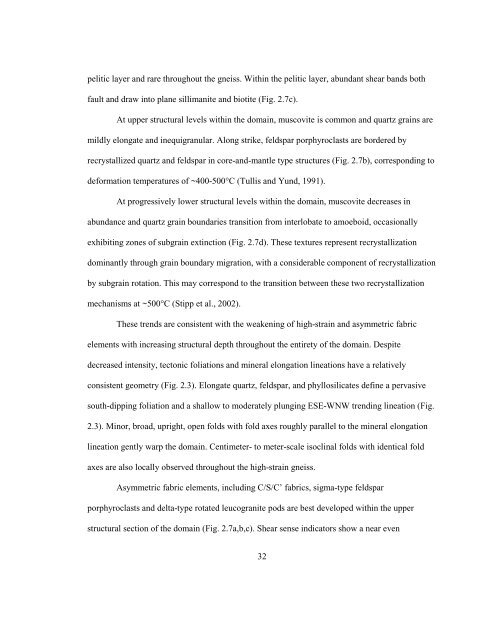title of the thesis - Department of Geology - Queen's University
title of the thesis - Department of Geology - Queen's University
title of the thesis - Department of Geology - Queen's University
Create successful ePaper yourself
Turn your PDF publications into a flip-book with our unique Google optimized e-Paper software.
pelitic layer and rare throughout <strong>the</strong> gneiss. Within <strong>the</strong> pelitic layer, abundant shear bands both<br />
fault and draw into plane sillimanite and biotite (Fig. 2.7c).<br />
At upper structural levels within <strong>the</strong> domain, muscovite is common and quartz grains are<br />
mildly elongate and inequigranular. Along strike, feldspar porphyroclasts are bordered by<br />
recrystallized quartz and feldspar in core-and-mantle type structures (Fig. 2.7b), corresponding to<br />
deformation temperatures <strong>of</strong> ~400-500°C (Tullis and Yund, 1991).<br />
At progressively lower structural levels within <strong>the</strong> domain, muscovite decreases in<br />
abundance and quartz grain boundaries transition from interlobate to amoeboid, occasionally<br />
exhibiting zones <strong>of</strong> subgrain extinction (Fig. 2.7d). These textures represent recrystallization<br />
dominantly through grain boundary migration, with a considerable component <strong>of</strong> recrystallization<br />
by subgrain rotation. This may correspond to <strong>the</strong> transition between <strong>the</strong>se two recrystallization<br />
mechanisms at ~500°C (Stipp et al., 2002).<br />
These trends are consistent with <strong>the</strong> weakening <strong>of</strong> high-strain and asymmetric fabric<br />
elements with increasing structural depth throughout <strong>the</strong> entirety <strong>of</strong> <strong>the</strong> domain. Despite<br />
decreased intensity, tectonic foliations and mineral elongation lineations have a relatively<br />
consistent geometry (Fig. 2.3). Elongate quartz, feldspar, and phyllosilicates define a pervasive<br />
south-dipping foliation and a shallow to moderately plunging ESE-WNW trending lineation (Fig.<br />
2.3). Minor, broad, upright, open folds with fold axes roughly parallel to <strong>the</strong> mineral elongation<br />
lineation gently warp <strong>the</strong> domain. Centimeter- to meter-scale isoclinal folds with identical fold<br />
axes are also locally observed throughout <strong>the</strong> high-strain gneiss.<br />
Asymmetric fabric elements, including C/S/C’ fabrics, sigma-type feldspar<br />
porphyroclasts and delta-type rotated leucogranite pods are best developed within <strong>the</strong> upper<br />
structural section <strong>of</strong> <strong>the</strong> domain (Fig. 2.7a,b,c). Shear sense indicators show a near even<br />
32

















